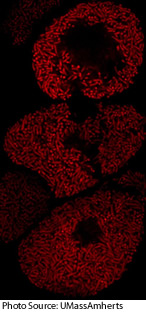
Biologists Found How Plants Interact with Beneficial Microbes in the Soil
January 13, 2016| |
 For years, scientists wondered how legumes recognize nitrogen-fixing bacteria as both friendly and distinct from their own cells, and how the host plant's specialized proteins find the bacteria. A team of molecular biologists from the University of Massachusetts Amherst led by Dong Wang has found how a gene in the host plant encodes a protein that recognizes the cell membrane surrounding the symbiotic bacteria, then directs other proteins to harvest the nutrients.
For years, scientists wondered how legumes recognize nitrogen-fixing bacteria as both friendly and distinct from their own cells, and how the host plant's specialized proteins find the bacteria. A team of molecular biologists from the University of Massachusetts Amherst led by Dong Wang has found how a gene in the host plant encodes a protein that recognizes the cell membrane surrounding the symbiotic bacteria, then directs other proteins to harvest the nutrients.
The team looked at the gene SYNTAXIN 132, which encodes receptors (SYP132) that identify cell membranes, and interact with secretory vesicles. They found that the gene usually makes a transcript that always seeks out the plant cell's surface membrane. But if rhizobia are present in the host, that same gene will make a second type of protein that is able to find the membrane surrounding the bacteria. Surprisingly, symbiosis with arbuscular mycorrhizal fungi shares the same SYP132 receptor. Scientists now understand that the host membrane – both in legumes and beyond – around the fungal arbuscule has a lot in common with the membrane around the nitrogen-fixing bacteria.
For more details, read the news article at the UMassAmherts News and Media Relations.
| |
Biotech Updates is a weekly newsletter of ISAAA, a not-for-profit organization. It is distributed for free to over 22,000 subscribers worldwide to inform them about the key developments in biosciences, especially in biotechnology. Your support will help us in our mission to feed the world with knowledge. You can help by donating as little as $10.
-
See more articles:
-
News from Around the World
- Scientists Complete Bread Wheat Genome Sequence
- USDA APHIS Opens GE Creeping Bentgrass Deregulation Petition for Public Comment
- Drought Hit Cereal Harvests Hardest Since 1980s
- Biologists Found How Plants Interact with Beneficial Microbes in the Soil
- USDA FAS Releases Report on Status of GE Feeds and Regulations in Taiwan
- Pakistan's Punjab Seed Council Approves New Crop Varieties
- Dandelion Latex Protects Roots from Feeding Insects
-
Research Highlights
- Distribution of Transgenes in Wheat Co-transformed through Particle Bombardment
- LcGST4 Functions in Anthocyanin Accumulation in Lychee
- Overexpression of Rice Gene ADI1 Enhances Naphthalene Tolerance in Arabidopsis
-
Beyond Crop Biotech
- Team Sequences Genome of Ancient Bacteria from Ötzi the Iceman's Gut
- Functional Analysis of ACS-Like Genes from Physcomitrella patens
-
Announcements
- BIO International Convention
-
Resources
- ISAAA Infographic: 19 Years of Biotech Crops in the World
- Genetic Engineering of Important Breeding Traits in Solanaceae and Cucurbitaceae
-
Read the latest: - Biotech Updates (December 17, 2025)
- Gene Editing Supplement (December 17, 2025)
- Gene Drive Supplement (February 22, 2023)
-
Subscribe to BU: - Share
- Tweet
